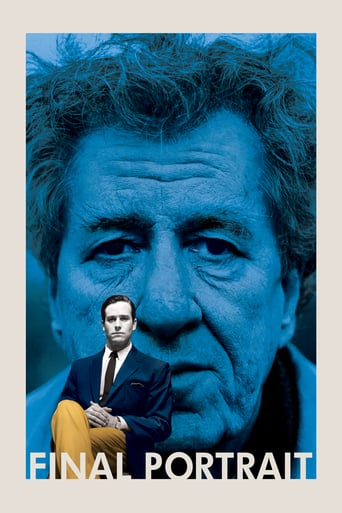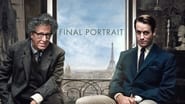robertjarmstrong
I figured that by the end of the picture something would happen to explain why this story was being told, what the protagonist would have revealed to him other than an onslaught of schmoozing, name-dropping and "posing" (pun intended). Instead it pretty much follows as it began, with celebrities (We'll take their word for it) of the early Sixties enjoying pleasant conversations about this or that for the sake of saying "I know famous people." I think a more seasoned writer would have developed a pursuit of why the characters are propelled forward into this action that, instead, just seems to keep repeating itself. As Homer Simpson might say about some of his own TV episodes "It's just a bunch of stuff that happened." Probably a storytelling technique was in place in the original book that doesn't quite work as a movie. I made sure to return the video to Red Box before midnight so I didn't have to pay for two days' rental. Honestly I didn't hate it -- one might say it got my mind to relax about as well as a TV talk show could. It just didn't add anything. At least it was only ninety minutes long, although here I suspect that the short duration was a clue to the film's vacuousness.
JEF7REY HILDNER (StoryArchitect)
My Silver Knight Riff1. I think a lot of people, especially artists, will enjoy this movie, even though it's kind of slow. Kind of like watching paint dry.Ouch. Sorry. Does that sound unfair? Too harsh? Well, maybe, but don't get me wrong. I really like the movie. I like slow. I like watching paint dry. I'm a painter. And so this movie speaks to me. I admire it. I admire Alberto Giacometti, whose life and mind I didn't know a whole lot about. I admire the screenwriter and set designer and all other facets of this refined 1h 31m movie--a terrific example of the Jean-Luc Godard concept that a movie is "the world in an hour and a half."In all kinds of satisfying ways, FINAL PORTRAIT paints a compelling portrait of Art.2. But I'm just being honest with you. Because when I went to see FINAL PORTRAIT the other night at the 1938 Art Moderne architectural gem the Tower Theater here in Sacramento, California, that thought, "like watching paint dry," flashed through my mind 1/2 way through the movie.A movie about a painter and painting and paint.So in a way, you can't help yourself having this thought, right? But it interrupted my concentration. I was sitting there in the theater as focused on the screen as Giacometti on his canvas. The film hooked me. But my mind wandered. Which broke the spell.Why?Because as this moment signified, when you get right down to it, the story design of FINAL PORTRAIT lacks the multi-dimensional development and depth that produces a sustained and irresistible emotional response. 3. I wanted more from FINAL PORTRAIT than intellectual appreciation. I wanted to feel and experience what I'm always hoping a movie will deliver--what all types of art will deliver, but especially a movie: what Robert McKee calls "aesthetic emotion" . . . and what the ancient Greeks called catharsis. Related concepts, but not the same.And when I watch a movie, I can't help yielding to the upwelling of these two magical forces any more than Jude Law's leaky-faucet character, Graham, can avoid tearing up in THE HOLIDAY. But FINAL PORTRAIT didn't trigger in me these emotions. I went into the theater hoping to come out like Jude Law's Graham. But I exited the theater like Cameron Diaz's Amanda. Dry eyed. 4. FINAL PORTRAIT didn't affect me the way I expect a great story exceptionally well told to affect me. But FINAL PORTRAIT is a treat for our eyes, ears, and soul. And it is most definitely a good story well told. And the movie takes me back 25 years ago to memories of seeing 32 SHORT FILMS ABOUT GLENN GOULD. (24 Short Films About Glenn Gould for my mom, because she entered the theater late and missed 1/4 of the film.) Makes me want to see both movies again. The pianist and the painter.And for 25 years, I've been breathing in Glenn Gould's artistic spirit and intellectual temperament, and to at least some degree they've infiltrated my being. I already feel the same thing happening because of FINAL PORTRAIT's rendering of Alberto Giacometti.I'll take what I saw and learned from the filmmakers' portrayal of him and their portrayal of art back to my studio to paint and repaint a new portrait of myself.For years to come.5. A few quick notes about the actors. Armie Hammer, in the role of James Lord, the American writer who narrates the movie and the model for Giacometti's final portrait, strikes an appealing pose in his reserved way as he did even more so in one of last year's most exquisite films, CALL ME BY YOUR NAME, for which James Ivory (at 89) so deservingly won the Academy Award for Best Adapted Screenplay.And Geoffrey Rush . . . well, such a wonderful actor . . . what an engaging and compelling portrait of Alberto . . . his spirit . . . heart . . . mind . . . . His face molded by the filmmakers into a likeness of one of Giacometti's sculptures . . . his physicality makeupped and dressed to reflect the gray of his paintings. What a gift for Rush to play such a role. And he gives us the gift of his art in return.Tony Shalhoub portrays Alberto's faithful gatekeeper-brother Diego so well too. Understated and nuanced. And Annette (Sylvie Testud) and Caroline (Clemence Poesy) also well written, cast, and rendered too. Pretty much not a wrong note by the artists of the cast and the artists who comprise the filmmaking team.6. We get lines that educate and entertain about Giacometti himself, his artistic process and exacting patient search, and other artists about whom Giacometti has fascinating things to say, succinctly honoring Cézanne, nothing surprising revealed there, but slamming Picasso, way surprising. And even James weighs in about Dora Maar and Cézanne's wife in witty lines of exposition and observation.I also liked the brief scene of Alberto doing coffee with actor James Faulkner's Matisse--a surrealist twist given that Matisse died in 1954, 10 years before the time of the movie. So Giacometti liked Cézanne and Matisse, but not Picasso? That's OK with me--Cézanne and Matisse are the two kings on the chessboard of modern painting. Picasso himself knew that. But disappointing to learn that Giacometti undervalues the importance of Picasso and Braque and Analytical and Synthetic Cubism. Especially when Giacometti's sculptures and paintings reflect their influence.7. I guess the deepest most lasting impression for me--if I were to fast forward 25 years to what I might then look back and recall--will likely prove to be the pleasing feature that struck me right off the bat: the muted, gray color palette of a movie about the artist called the "Grey One." The filmmakers paint the look and feel of Giacometti's World in tones of gray, warm and cool. A World, an Arena, that includes his Studio . . . and his Home . . . and the Courtyard that connects them--the Space between that unifies the turbulent angst of Giacometti's somber intense melancholy gray world of Work and Love.Freud said those are the two basic human needs. The two that most people need fulfilled to feel happy. Work and Love.FINAL PORTRAIT gets that.8. We see the twilight struggle of Alberto's Inner World at the end of his life given poetic expression through the gray portrait of the artist's Outer World. A world of light and shadow and hazy windows and mirrors and broken glass . . . quasi reflections of emotional truth and complex gray human relationships . . . reinforced through the subtext of Giacometti's compressed and mid-toned work-and-love venue where the unfolding of the drama of his life takes place.I believe that architecture is the stage set for the drama of life--the drama of life and death. The world in a building. The filmmakers of FINAL PORTRAIT are in touch with these concepts.9. The set design of Giacometti's studio features sculptures ranging in size from XL to XS. We see variants of Giacometti's trademark sculptures: stick-like, elongated, vertically distorted--an echo of El Greco. But we also see more classically volumetric studies, including an XL sculpted head that Giacometti especially adores. A self-portrait? Probably. Like all of his work. And this particular sculpture of an XL face helps us grasp Giacometti's brave eccentricity and obsession with the plasticity and rugged terrain of the human head. Sculpted and molded by the artist's hands as if by God from the clay of the earth--but sculpted true to Cézanne's view of the world as formed essentially by geometric primaries: cubes, cones, cylinders, and spheres. We get the feeling that all of these sculptures are Giacometti's best friends. Expressions of his zest, life force, and love. And through the art of film, we view Giacometti in a studio where sculptures of people interact visually and symbolically with flesh-and-blood human beings, all in a crowded sacred space that runs on the psychological energy and physical work of the artist and on the fuel of the tense interplay of the artist's and his models' minds and emotions--from buoyant Caroline, Alberto's prostitute girlfriend, so eager for him to paint her portrait . . . to low key James who's honored to sit for the artist but can't wait to leave Paris and get back to New York . . . to agonized Annette, the wife, distraught but steadfast and accepting.10. FINAL PORTRAIT presents the layered emotional choreography of this odd ensemble of souls, united by Alberto Giacometti's fiery passion, on a stage set of life where the artist isn't the typical starving artist. Just the opposite. Giacometti is so successful selling his art that he has money to burn. But he doesn't care. Because he knows that money can't buy him the one thing he really wants--what all artists worth their soul really want:Truth.11. I didn't know anything about this movie before it started. Zero. Only the title. Just the way I like it. So I had no idea it was about Giacometti. Or who was cast in the roles of a screenplay I didn't know who wrote. So the credits at the end revealed the beautiful surprise. Wow. Way to go Stanley Tucci. Director and Writer. Thanks to James Lord and your sensitive adaption of his memoir "A Giacometti Portrait," you've painted the canvas of the silver screen with beautiful brush strokes, evoking in me associations with James Joyce through your Portrait of an Artist as an Old Man.My Silver Knight Rating of FINAL PORTRAIT:White Knight (Form): 8.0Black Knight (Story): 7.0=Silver Knight (Form & Story): 7.57.5 CamerasThe Silver Knight Rating scores a movie's level of play in what I call the Chess Game of Art. (See my IMDb commentary on ARRIVAL.)





